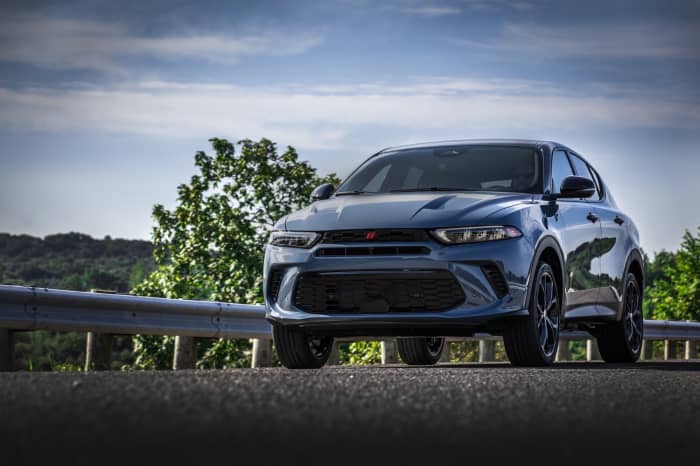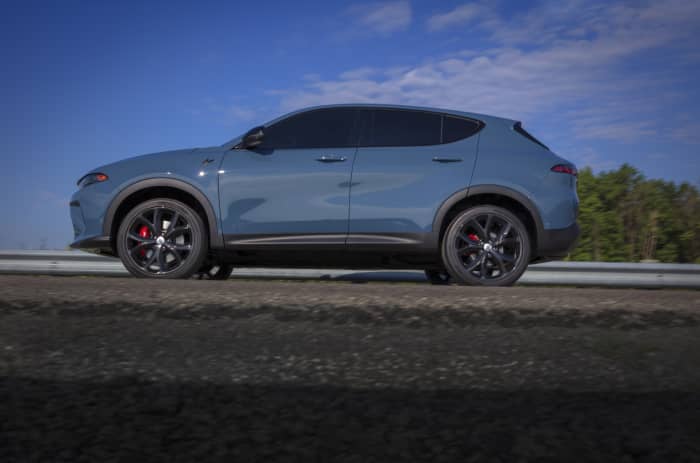This post was originally published on this site
Dodge makes muscle cars. Americans buy more practical little crossovers.
If you’re Dodge, this presents you with a challenge: How do you turn the kind of buyer that wants a functional small SUV into someone that will spend the next few decades identifying with Dominic Toretto and the lifelong fans Dodge calls “the Brotherhood of Muscle”?
Their answer? A gateway drug. A rocks glass of pragmatic compact crossover with a shot of muscle car attitude back. Meet the 2023 Dodge Hornet.
Dodge hasn’t revealed the insect’s exact price yet, but, meeting with reporters, CEO Tim Kuniskis called it “the most powerful SUV in the compact segment under $30,000.” That figure likely represents the base model’s sticker price.
An Alfa Romeo through Dodge-colored glasses
First things first – the Hornet is based on the Alfa Romeo Tonale. It wasn’t designed from scratch as a Dodge.
But, Kuniskis notes, the original Dodge Charger was built on the Chrysler 300 frame and took on a personality all its own. The Hornet, Dodge believes, will do the same.
It does it with a muscular Dodge front fascia grafted onto the Euro curves of the Tonale. Deep character lines in the hood draw back from a pair of horizontal slits (Dodge calls them “heat extractors”) above a grille that could fit on any Dodge muscle car from the last 10 years.
A single taillight stretches across the rear of the Hornet, with the two slash marks Dodge calls its “rhombi logo” in the center.
The entry-level GT model rides on 17-inch alloy wheels. A step up to the R/T model brings 18-inch Graphite Grey alloys with black anodized Brembo
BRE,
front brake calipers wearing the Dodge logo.
A Blacktop Package adds gloss black wheels, mirror caps, badges, and body molding to create what Dodge calls… come on, you know it’s coming… “the automotive version of a murder Hornet.”

The entry-level 2023 Dodge Hornet GT is powered by the Hurricane4 engine, a 2.0-liter turbocharged inline four-cylinder with direct fuel injection.
Dodge
Driver-first cabin, premium touches even in base model
Inside, the center stack is slightly canted toward the driver for that cockpit feel. The driver’s digital instrument screen is larger than the central touchscreen – 12.3 inches compared to 10.25 – contributing to the sense that driving is the entertainment here.
Even lower-end trims get red contrast-color stitching and a flat-bottom steering wheel – usually touches reserved for performance versions.
Wireless Android Auto and Apple
AAPL,
CarPlay are standard as part of the Uconnect 5 user interface. It also allows owners to save profiles that adjust the home screen layouts, music preferences, HVAC controls, and seat positions to the preferences of each driver.
An available 14-speaker Harman Kardon sound system puts out 465 watts of power.
This being a family-friendly Dodge, there’s also a rear-seat reminder system that “registers rear entry/exit with each key cycle and uses a chime and message display to remind the driver to check the rear seat.”

The 2023 Dodge Hornet
Dodge
Two trims, one hybrid
Dodge knows that most people who buy small crossovers have different priorities than the typical Dodge shopper.
“Power, acceleration, fun-to-drive. These things are at the end of the list” for the typical compact SUV buyer, Kuniskis says. But that creates an opening for a performance-centered brand. “This seemed like the perfect little politically-correct segment for us to go in and rile up,” he explains.
The Hornet comes in two trim levels, with one being a plug-in hybrid (PHEV) version.
Learn more: What is EV, BEV, HEV, PHEV? Here’s your guide to types of electric cars
The base GT model uses a 268-horsepower 2.0-liter turbocharged 4-cylinder engine from Dodge’s new Hurricane lineup. It sends power through a 9-speed automatic transmission to a full-time all-wheel-drive (AWD) system. Zero to 60 mph comes in 6.5 seconds – a quick figure for this class and a reasonable case for Dodge’s argument that this car is gateway muscle.
A step up to the R/T model gets a smaller 1.3-liter turbocharged 4-cylinder mill but mates it to an electric motor for a total of 288 horsepower. Most of the time.
Twenty-five more horsepower are available at the touch of a button. R/T models use a 6-speed automatic transmission with paddle shifters. A boost Dodge calls “Powershot” kicks in if you pull on one of the paddles, adding a boost of “pull-to-pass” power.
And, though Dodge advertises the R/T’s PHEV system as a performance feature, it’s good for “more than 30 miles of all-electric range” before you have to use a drop of gasoline.
A place for Dodge in the electric future
That, in the end, may be the Hornet’s most crucial trick.
Dodge plans to transition to electric power – it premiers a future “electric muscle car” tomorrow. But Dodge fans expect attitude and performance above all else.
It’s one thing to argue that the Hornet is the “gateway to Dodge muscle.” It’s another to think that what’s behind the gate looks anything like the Dodge muscle of today.
Can the company sell a reskinned Alfa Romeo with an electric motor as the point of entry to the Brotherhood of Muscle?
We’ll need some time in the seat to tell whether the Hornet is something entirely different or a repackaged compact SUV like all the others. If it’s everything it promises to be, it could help lead the car brand most closely associated with the burble of a V8 into a high-performance future without big engines.
Third model coming? Hints of a high-performance version
Dodge displayed a third Hornet model at this week’s Speed Week event. That one is officially a concept. But it was built entirely with parts available from Dodge’s Direct Connection aftermarket parts portfolio.
It’s called the Hornet GLH concept (short, Kuniskis says, for “goes like hell”). It’s “nothing that should be in this segment,” the CEO says. With a lowered suspension, 20-inch wheels, and a cat-back exhaust, it pays tribute to the Dodge Omni GLH of the 1980s. But, Dodge claims, it has a better power-to-weight ratio. There’s no word on whether it will see production. But we can’t help but note that Dodge already has all the parts to build it.
This story originally ran on KBB.com.

